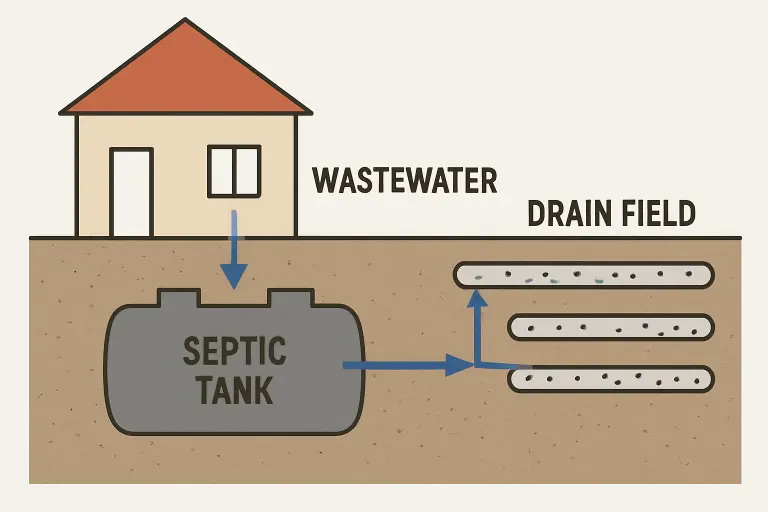Table of Contents
- Understanding Septic Systems
- Types of Modern Septic Systems
- Installation Considerations
- Maintenance Tips
- Common Issues and Solutions
- Environmental Impact
- Regulatory Requirements
- Conclusion
Homeowner’s Guide to Modern Septic Systems
For many homeowners, particularly those in areas lacking municipal sewage connections, septic systems serve as the backbone of residential wastewater management. A well-designed septic system efficiently handles household plumbing waste, promoting a healthier home and environment. Engaging professionals for setup and maintenance helps prevent costly and inconvenient failures. Septic tank installation & repair in Cincinnati local specialists can provide expert guidance and services, ensuring your system functions properly from day one. Familiarity with key septic system concepts empowers homeowners to make informed decisions and proactively manage their properties’ onsite wastewater needs.
Modern innovations in septic system technology have led to increased efficiency, dependability, and adaptability. By understanding the types, maintenance needs, and regulatory aspects of today’s systems, homeowners can safeguard their households and surrounding ecosystems.
Understanding Septic Systems
A septic system is an underground wastewater treatment method that processes and purifies sewage from homes that are not connected to a central sewer line. The core components include the septic tank—which separates solids from liquids—and the drain field, which filters the liquid effluent through layers of soil. Over time, natural bacteria break down organic material, rendering water clean enough to re-enter the environment. The ongoing operation of a septic system is dependent on both biological action and mechanical parts. Homeowners play a crucial role by ensuring that only appropriate waste enters the system and by arranging regular maintenance.
Types of Modern Septic Systems
Advancements in septic technology offer homeowners several system options suited to diverse site conditions:
- Conventional Systems: These classic systems feature a septic tank paired with a series of trenches or beds in the soil for filtration. Best for properties with favorable soil and ample space.
- Chamber Systems: These rely on connected chambers, rather than gravel, to contain and filter effluent. They are easier to install and more adaptable to different soils.
- Drip Distribution Systems: By employing small-diameter pipes set shallow in the ground, drip systems disperse effluent over a wide area, reducing the impact on any one part of the landscape. According to HowStuffWorks, these systems are beneficial for properties with shallow soil or uneven terrain, where traditional trench systems may not be practical.
- Aerobic Treatment Units (ATUs): ATUs use oxygen to promote faster breakdown of waste, making them ideal for sites with high water tables or challenging soils.
Installation Considerations
Proper installation determines a septic system’s long-term reliability and environmental safety. Critical elements include:
- Soil Type: Soil permeability directly affects drainage and filtration. A soil test is mandatory to match the system to the site.
- Topography: Slope, distance from water sources, and location relative to buildings are all key considerations for preventing contamination and ensuring safe operation.
- Household Size: The number of bedrooms or daily water usage guides the tank and drain field sizing, preventing overload and potential system failure.
Maintenance Tips
Effective maintenance practices prolong system life, prevent most issues, and minimize costly repairs:
- Regular Inspections: A certified specialist should inspect tanks and pipes every 1-3 years.
- Pumping: Pumping the tank every 3-5 years eliminates solids before they can clog or damage the system.
- Water Conservation: Using water-efficient fixtures and staggering water-intensive tasks helps prevent system overload, allowing for proper filtering action.
- Proper Waste Disposal: Only flush biodegradable materials. Never send grease, paint, medications, or “flushable” wipes into the septic system, as these can cause blockages and harm microbial activity.
Common Issues and Solutions
Awareness of symptoms and prompt action are the keys to resolving problems before they escalate:
- Slow Drains or Backups: Clogs in the pipes or tank baffles can cause sluggish draining. Use only septic-safe methods or consult a professional.
- Odors: Persistent smells could indicate a full tank, blocked vents, or leaks—each requires swift action to prevent health hazards.
- Wet Spots in the Yard: These suggest a failing drain field or leaking pipes. Prompt professional inspection and repair are necessary to avoid contamination and bigger repairs.
Environmental Impact
Modern septic systems, when designed and maintained correctly, contribute to cleaner groundwater and reduce pollution. They treat wastewater on-site, preventing hazardous substances from entering local waterways. Failing septic systems, in contrast, can release untreated effluent, contaminating wells, rivers, and public recreation areas. This not only poses significant health risks but can also disrupt local wildlife habitats. Regular care protects both families and the broader ecosystem.
Regulatory Requirements
Adherence to local and state regulations is crucial. Most jurisdictions require permits for installation or significant repairs, enforce zoning restrictions on septic system placement, and may mandate inspections or maintenance schedules. These rules safeguard public health and guarantee that systems perform as designed. Homeowners are encouraged to contact their local health department for site-specific requirements.
Conclusion
Modern septic systems provide an efficient and environmentally responsible means of wastewater management for homes not connected to public sewer systems. With regular inspections, appropriate waste habits, and compliance with regulatory schedules, homeowners can ensure their septic systems provide reliable service for decades. Proactive attention and working with qualified septic professionals make all the difference in protecting both property value and the environment.
Also Read-


